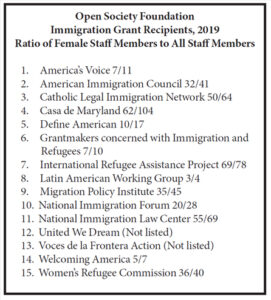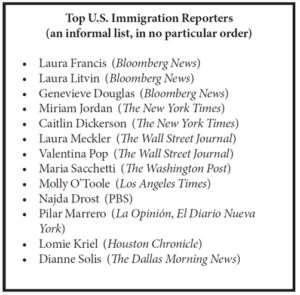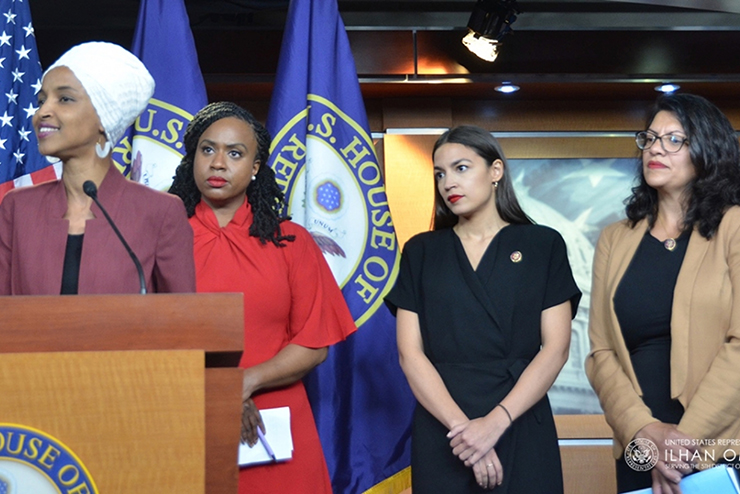U.S. Democrats have tried and failed thrice at stuffing an illegal-immigration amnesty provision into President Joe Biden’s Build Back Better budget reconciliation bill. This attempt at tagalong legislation for illegals would not have been tried even just a few years ago. In 2018, during their last big push to legalize America’s mammoth illegal-immigrant population, the Democrats (along with many Republicans) sought to do so through regular stand-alone legislation, just as with all previous attempts.
Few would disagree that the Democratic Party is becoming increasingly strident (even undemocratic) on the topic of amnesty and other immigration issues. According to a 2007 Pew Research report, when asked about the impact of illegal immigration on American jobs, Democrats expressed more worry about it than did Republicans.
As with so many other immigration actions on Capitol Hill, this most recent amnesty push has no more passionate advocate than Rep. Alexandria Ocasio-Cortez. Earlier this month, she publicly demanded that the Senate disregard two recent parliamentarian opinions declaring that amnesty had no business being inserted into a fast-tracked, must-pass budgetary bill. Her brazenness was striking, considering that if the bill were to pass, it would surely open the door to any legislative issue from either party getting rammed through the Senate outside of the regular process, which requires 60 votes on normal bills where a filibuster is raised. Needless to say, the congresswoman was not looking at the issue through rational, systemic analysis. For her, this was policy based on emotional “reasoning” alone.
Such an emotive approach to policymaking no doubt informs our society’s increasing amenability to mass amnesty and general immigration permissiveness. Ocasio-Cortez has been described by The New York Times as being among the “vanguard of the party’s new direction,” where her all-female “squad” is at the forefront of previously unheard-of ideas, like completely abolishing frontier immigration enforcement.
I propose that this “immigration wokeness” is an expression of an increasingly feminized America. That is, an America where women’s participation in political and social questions has reached a tipping point. If, as Hillary Clinton told a crowd of women supporters in 2017, “the future is female,” that future is coming to pass, and it can be seen in America’s immigration policymaking.

I recently reviewed the staff lists of 13 prominent open-borders organizations. Among them, three-quarters of all staffers—a whopping 391 of 518—were women. Four of the five biggest organizations (each employing at least 45 people) were 80 percent to 90 percent female. Moreover, a disproportionate number of the male staffers at these groups were in support roles such as finance and IT—not in the advocacy roles that are the organizations’ primary activity.

I also reviewed the immigration-practice section of the ultra-liberal American Bar Association (ABA)—which takes the rather breathtaking position that employers should not be verifying the lawful immigration status of their employees. The staff list (including advisors) for this ABA-practice section is also three-quarters female. Furthermore, the ABA also has three pro bono units that provide free legal representation to adults, children, and asylum-seekers in immigration custody: the San Diego–based Immigration Justice Project, the Children’s Immigration Law Academy, and the South Texas Pro Bono Asylum Representation Project. Based on online staff photos, 73 percent of the first pro bono unit and the entirety of the last two pro bono units are female.
This is striking. The gender balance is so skewed in these organizations that surely something outside of chance explains it. It’s likely that women on average are more prone to view immigration through an altruistic or emotional lens, and that female lawyers may be drawn to work for organizations that push more lenient immigration laws. Pew Research polls conducted in 2007 and 2018 do show that the sexes differ considerably (by around eight points) on issues like immigration amnesty.
What we know for certain is that female-dominated advocacy groups are helping to liberalize and feminize U.S. immigration policy. Like all advocacy groups, the aforementioned engage in congressional and administrative lobbying, strategic lawsuits, and pro (or “low”) bono legal protection programs, as well as social media and public-outreach campaigns. The media, of course, are an integral part of the latter. Immigration journalism—at most major U.S. newspapers, at least—appears to be dominated by women as well. Women seem more drawn to this niche field of journalism. And, in turn, by applying a naturally more empathic, feminine touch to their reporting, they themselves are likely shaping the way the issue is viewed.

Such speculations are completely reasonable as public opinion on immigration has changed markedly over the last several decades. In 2001, for instance, a Gallup poll showed that just 6 percent of Americans supported amnesty—an attitude likely linked to the disastrous Immigration Reform and Control Act (IRCA) of 1986, which, right after it passed, produced a flood of unlawful immigration. Things had softened by 2007, when the McCain-Kennedy amnesty bill was debated; however, opposition still outweighed support.
By 2014, just after the Rubio-Schumer Gang-of-Eight bill failed, those opposing amnesty became a minority for the first time, as indicated by Pew Research data, and roughly two-thirds of the population backed the push in general (albeit with a gaping hole of 24 points between Republicans and Democrats). In 2018, when Sen. Chuck Grassley’s amnesty bill was introduced, Pew Research shows that this supporting two-thirds had grown to three-quarters.
This is a considerable increase from the 6 percent approval rate in 2001. As Gallup noted at the time, public opinion on immigration had not moved much since the 1960s, when polling on the topic first began. Americans reliably wanted immigration either reduced or frozen, with those supporting an increase hovering at only around 14 percent. According to a 2019 New York Times article, 56 percent of white Democrats wanted an increase—up from about 5 percent in the 1990s.
Female political engagement likely explains much of this. After all, since 1980, women have out-voted men and have increased their representation in elected office many times over. During the same period, the student body on U.S. campuses went from gender parity to nearly 60 percent female, as noted in a September 2021 issue of The Wall Street Journal. Obviously, shifts like these in the electorate, as well as in social advocacy and cultural power more broadly, can have big effects on national public policy.
In any case, a connection between the increase of political activity among women and permissiveness towards high immigration, amnesty, refugees, and so on, seems to have solid grounding. Failing to understand the innate differences between how women and men approach issues like immigration is to neglect a crucially important social question.
In his 2012 best-selling book, The Righteous Mind, social psychologist Jonathan Haidt famously reports his finding that a key moral motivator for liberals when it comes to social and political issues is care for the suffering—the other major one being fighting for the perceived oppressed. He dubs this trait the “Care foundation.” Notably, he says that “mothers who were innately sensitive to signs of suffering, distress, or neediness improved their odds [for procreation], relative to their less sensitive sisters.” Evolution, he writes, favored women “who had an automatic reaction to signs of need or suffering, such as crying, from children in their midst.” For females, in other words, care for and sensitivity to the needs of minors and others was evolutionarily adaptive.
One can see how enhanced sensitivity to others might play a role in issues like immigration. That this area of policy focuses so squarely on people, especially the poor and, far too often, minors, would seem to make it a strong Care-foundation trigger. Think of the extreme reaction to the death of Alan Kurdi, the Syrian child who drowned when his parents tried to take an inflatable boat to Greece from their home in Turkey. Or why mass amnesty has been largely built around “dreamer” minors (immigrant youths who qualify for the Development, Relief, and Education for Alien Minors Act). Or the Democrats’ outrage in 2017 over “ripped-apart families” along with pictures of minors in cages, something Democrats are still leveraging today—even though we’ve always separated children from parents arrested for crimes, including for unlawful entry. Children, writes Haidt, “prime us to care, nurture, protect and interact”—especially those whose moral matrix rests so heavily on the Care foundation.
Haidt underlines that the Care foundation can be triggered by any child, not just one’s own. This floating mothering trigger perhaps helps explain the so-called marriage gap. A 2016 Pew Research report revealed that since 1980 women on average have been 8 percentage points more likely to vote Democrat (the “Care party”) than men. But there’s a vast difference here depending on marriage. For instance, in the last four general elections, unmarried women voted far more heavily Democrat than did their married counterparts.
If allowed to bleed into policy discussions in sufficient quantities, an empathetic approach focused on one group within the larger system can work like sand in the gears of good, sober, cost-benefit analysis that takes into consideration how all groups will be affected.
Several strong reasons have been put forward to explain the marriage gap: women hearing convincing Republican arguments from their husbands; women voting in accordance with their husbands’ economic interests; and women replacing hyper-individualism with long-term family considerations. It would only make sense that married women’s natural altruism is more likely expressed in relation to their own children than to immigrant strangers. Guided by unfulfilled motherly impulses, unmarried women may seek to guard other children or similar vulnerable types—like refugees and illegal aliens—treating and protecting them like the kids they never had.
After all, there are scores of “childless mother” organizations, websites, and scholarly articles discussing the sense of loss commonly felt by women who involuntarily or by choice have no children. As evidenced by the proliferation of these support groups, there are plenty of these women around, especially among the educated. Educated women (the type, of course, who dominate social advocacy groups) have much lower fertility rates than do the uneducated.
Clearly, there is much in the field of evolutionary psychology to explain Haidt’s Care foundation vis-à-vis females and why they congregate in immigration advocacy. Charles Murray’s 2020 book, Human Diversity, contains an excellent survey of the most up-to-date psychological literature on sex differences. In the book, he sums up clinical findings, from psychologists like Diane Halpern and Judith Hall, that show women exhibit a special sensitivity towards people, emotion, and suffering. Elsewhere, he discusses findings that indicate women on average have more accurate and vivid “emotional memories” than do men.
To the extent that the assertion is accurate, one should expect such tendencies to inform women’s job motivation and career choices, in general. It is well accepted in clinical psychology that women prefer to work with other people in their jobs or careers. Men, by contrast, are more interested in systems and how things, not people, tick. Jordan Peterson, in a National Post article from 2018, calls this the “largest psychological difference between men and women yet identified” and says that “these differences drive occupational choice, particularly at the extremes.”
Going back to Haidt’s varying evolutionary journeys of the sexes, any explanation for women’s special motivation to choose work centered on people is likely based on their comparative ability to empathize. It is women’s greater ability to empathize, Murray says, in reference to numerous studies on the issue, that makes women more effective therapists, managers, and arbitrators. By contrast, because men tend to outshine in visuospatial skills, they gravitate toward computer programming, engineering, architecture, aviation, and the building trades. Even among those women who do go into STEM careers, Murray notes, there is more of an attraction to people-oriented life sciences (where they outnumber men two to one) and less to mathematics or the physical sciences.
Murray further cites a study from Vanderbilt on differing workplace values between the sexes. On top of preferring to work with people, women tend to prefer greater work flexibility and shorter work weeks, allowing them to maintain strong friendships and contribute to the community. At the extreme ends of the legal industry, for instance, this might mean choosing public interest law over commercial litigation or mergers and acquisitions.
Finally, there’s verbal intelligence. Surveying results of the K–12 Cognitive Abilities Test and the National Assessment of Educational Progress, Murray cites findings that show females consistently outperforming males on “a variety of verbal tasks, with a small advantage in reading and a more substantial advantage in writing.” In other words, many of the skills crucial for legal and advocacy work.
To summarize, women on average seem to have a greater capacity for empathy; a preference for working with people; a desire for work-flexibility and giving back; and a high verbal IQ: the combination of this mix of ability, temperament, and motivation should make it understandable why women gravitate toward social and legal advocacy work in the immigration space and elsewhere.

The next question is, why does it matter? Why should we care that such advocacy efforts are disproportionately female-led? The answer lies in the higher cost than benefit. An exclusively empathy-based approach does not consider costs, except with regard to the object of one’s empathy. Larger societal effects are too often simply overwhelmed by the intensity of one’s concern for a particular microcosm.
In discussing empathy, Murray notes that “entering into someone else’s mind calls on a different set of mental capabilities than the ones required for understanding a system.” His mention of systems deserves emphasis. Systemic thinking is crucial in understanding all the multiple ramifications and ripple effects of broad policymaking. It would seem especially important to the immigration area, which not only involves people and, therefore, provokes our compassion, but also affects so many other policy areas, including labor, welfare, housing, the environment, crime, national security, and the rule of law. If allowed to bleed into policy discussions in sufficient quantities, an empathetic approach focused on one group within the larger system can work like sand in the gears of good, sober, cost-benefit analysis that takes into consideration how all groups will be affected.
According to what psychologists call the “identifiable victim effect,” people are more likely to feel compassion for an unknown victim when that person is named and photographed. As a 2020 BBC article put it, “The charity that campaigns with a single story of a named, suffering child may win more donations compared with the charity that deploys statistics describing 1,000 anonymous children.”
In other words, people may not be able to recognize that a dollar spent on, for instance, a deworming program in the developing world would go much further than a dollar donated for an expensive procedure aiding a specifically named person. The BBC also cites a study showing a disturbing number of people who support putting a named, suffering child higher up in a hospital queue at the express expense of “numerous anonymous others.” Such a tendency—that is, to let an identified sufferer dominate one’s attention to the exclusion of systemically related but unidentified sufferers—is precisely what has been found to predominate among women.
Immigration clearly brings out the maternal instinct. Failing to step back from mainstream media’s routine human-interest stories about migrants and failing to appreciate the systemic effects of unlawful immigration, relaxed refugee standards, and so on, makes cost-benefit analysis and the resulting effective policies all but impossible. And it’s not as if the “cost” side of the ledger here is unclear.
For instance, some states have illegal migrant populations so large that up to a tenth of their entire work force are estimated to be unlawful, according to a 2018 Pew Research study. The adverse effects of such a situation are hard to ignore. Not only does such a vast number of incoming foreign workers arguably act like a weight on the wages and worker-benefits of society’s least well-off (especially in those industries where illegal migrants tend to congregate), but it also pressures public infrastructure, welfare coffers, and affordable housing—all the while encouraging the mass theft of Social Security numbers (a crime for which the large majority of victims, ironically perhaps, are children), as the Center for Immigration Studies points out.
But statistics and dry analysis do not evoke strong emotion, and the media does not even try adding a human face to these effects of illegal immigration.
The issue of amnesty has also shown the effects of misplaced empathetic thinking. That amnesty begets more illegal immigration is something the U.S. witnessed in the late 1980s following the IRCA and congressional amnesty of 1986. There was also the unaccompanied alien minor crisis of 2014, which many analysts connected to former President Obama’s executive Deferred Action for Childhood Arrivals (DACA) program, implemented in 2012.
Meanwhile, today’s border crisis is arguably in response to President Biden’s amnesty promises made during his campaign as well as to the Senate amnesty provisions currently being negotiated. Still, the mainstream media’s position seems all but unified on the issue, and again, polling shows that amnesty is more widely supported than ever.
At its barest, “wokeness” is an empathy-laden approach to political and social issues. It gives little consideration to national interest, cost-benefit analysis, or the effects of bad public policymaking. With regard to immigration especially, it is possible to show that sex differences reflected in temperament and career choice can help explain the short-sighted, sentimental approaches to policy that dominate the current political landscape.
“The Squad,” (left to right) Rep. Ilhan Omar (D.-Minn.), Rep. Ayanna Pressley (D.-Mass.), Rep. Alexandria Ocasio-Cortez (D-N.Y.), Rep. Rashida Tlaib (D.-Mich.) (staff of Rep. Ilhan Omar / public domain)

Leave a Reply